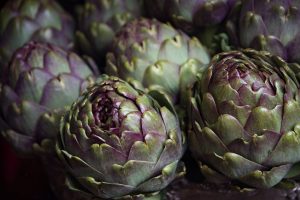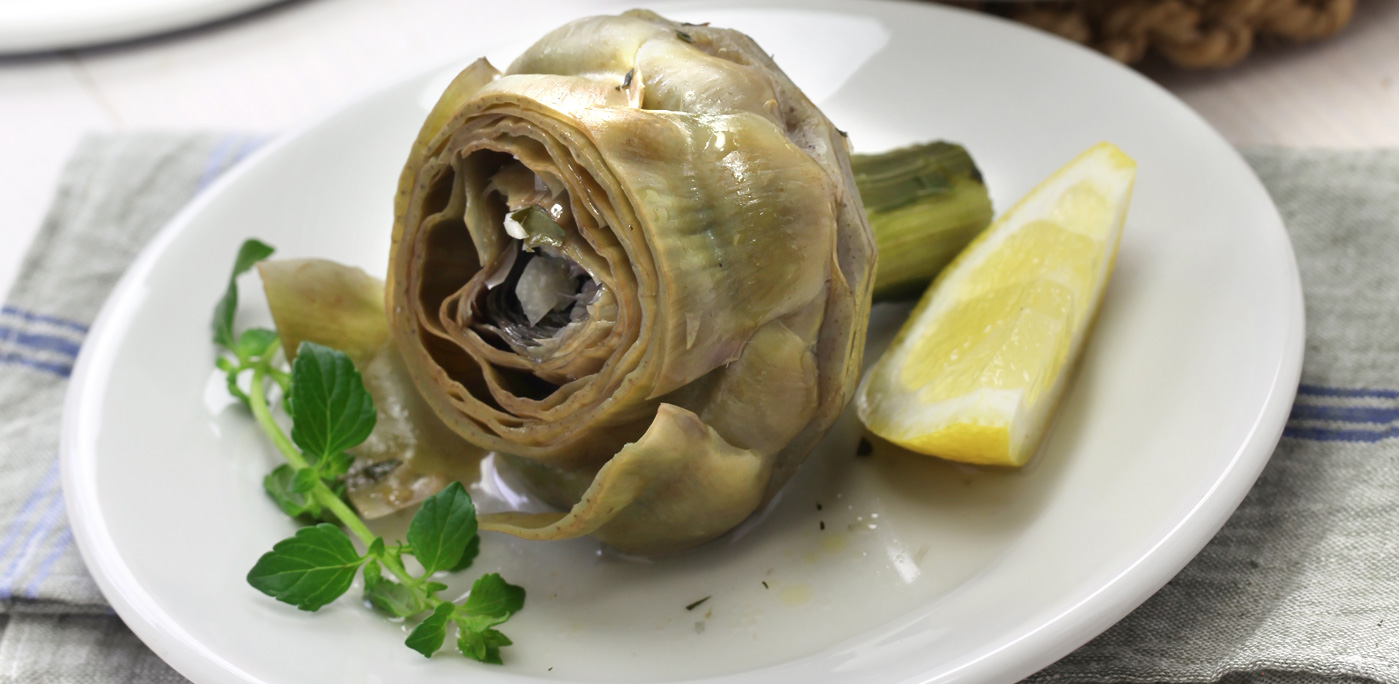It’s the beginning of artichokes season in Italy. This time of the year is when they are tender and not too big, in fact so tender that they can be eaten raw, thinly cut and simply seasoned with salt, olive oil and lemon juice. However, my favourite recipe for artichokes is an absolute classic dish from the Eternal City and it’s called ‘Carciofi alla Romana’. Growing up in the Italian Capital (and my dad being a 7th generation Roman), I was lucky enough to learn about traditional Roman cuisine and its use of fresh herbs.
One herb in particular was always essential for the preparation of this dish and it’s a special type of wild mint which mainly grows in the region surrounding Rome (Lazio): the very strong and pungent ‘mentuccia’. This herb is always available at the city markets, supplied by the vendors for free (provided, of course, you buy some vegetables from them). As I take a walk through the fields and olive groves Sabine Hills (a beautifully unspoilt rural area just north of Rome where I now live), the pleasant and fresh scent of this little herb accompanies me all the time: it’s everywhere. So, I am lucky as I have an endless supply of mint just at my front door.
Artichokes are a great vegetable: they are easy to grow, the plant is large, spiky, very prolific, perennial and resistant to different conditions. What you eat is essentially the bud. This means that, if you don’t pick your artichokes in time, they will develop into beautiful large purple flowers in the spring.
Although there is a very nice variety of early smaller artichokes that we call ‘violetti’, with an elongated shape and quite a few sharp spikes on the top, mainly grown in the sunny island of Sardinia, for ‘Carciofi alla Romana’ we generally prefer the fuller, rounder shape of the ‘romaneschi’ variety.
Roman cuisine is simple and it’s about the perfect combination of a small number of ingredients together and of course their quality. Some of the recipes can be traced all the way to Ancient Rome and the majority of them are at least several hundred years old. Someone must have discovered, at some stage in history, that artichokes, wild roman mint, garlic and lemon where the perfect combination. Also, there aren’t many ways you can cook artichokes in Italy. Boiling is absolutely out of question. You can deep fry them, bake them (as part of a pie or ‘torta rustica’) or pan fry them. In Rome we believe that the best way to keep the flavour intact is by using steam, so we braise them with olive oil.
As I child, I remember my mum rubbing a slice of lemon on her hands before starting preparing ‘carciofi alla romana’. Years later I discovered that this prevents your hands from getting stained by the artichokes. It’s almost as if they release a sort of dark purple ‘ink’ from their outer petals. Therefore, once we start discarding the outer leaves and start carving the artichoke, it’s important to rub it with lemon from time to time. An alternative is to dip them in water and lemon juice once they are carved. Next, we need to have some chopped garlic, salt and of course Roman mint at hand as we quickly prepare the artichokes to be braised.
I serve ‘Carciofi alla Romana’ both as a side dish or on its own and I think a perfect wine pairing is a dry, fresh white from the Roman countryside, such as ‘Castelli Romani’.
Carciofi alla romana (Roman style artichokes).

Serves 4: 4 artichokes, extra virgin olive oil, fresh mint, fresh lemon, finely chopped garlic, fine sea salt.
Prepare the artichokes by disposing of all the tough leaves and by peeling the bottom part and quickly rub half a lemon on them, which will prevent them from darkening.
Cut out the tip of the artichoke (about half an inch, depending on shape and size).
Stuff the artichokes with mint leaves, a little chopped garlic, salt and a little black pepper.
Put them upside down (stalk up) into a pot just large enough to contain them, pour a quarter of a glass of olive oil and half a glass of water on them.
Cover the pot and let cook until tender (the amount of time really depends on the type of artichokes, but usually is around half an hour).
Make sure there always moisture in the pot and add a little water if necessary.
You can test their tenderness by testing them with a fork: if the fork goes in easily, they are ready. By this stage, all the water should be reduced Into a lovely, thick juice combined with the olive oil.
Serve with a little fresh olive oil dribbled on top. I also add a few drops of balsamic glaze for decoration and taste.
Buon Appetito!





























